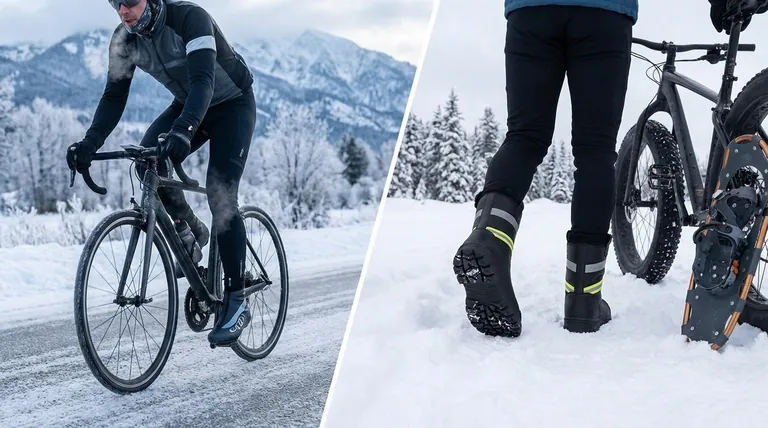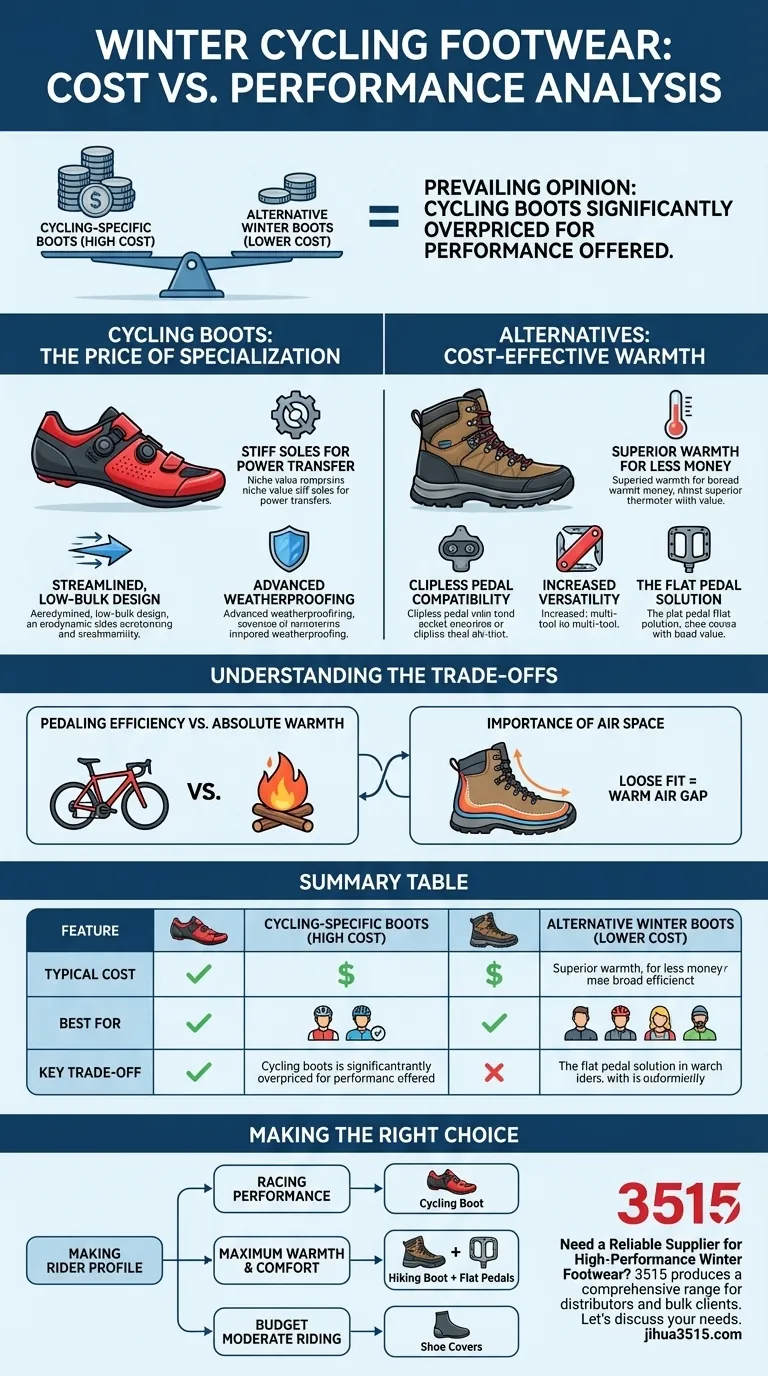In short, the prevailing opinion is that dedicated winter cycling boots are significantly overpriced for the performance they offer. Many experienced riders find that high-quality insulated hiking boots or even snowmobile boots provide equal or superior warmth and weather protection at a much lower cost.
The core issue isn't that cycling-specific winter boots are bad, but that their high price is driven by niche cycling features that may not outweigh the raw, cost-effective warmth offered by more mainstream winter footwear.

Why Are Cycling Boots So Expensive?
To understand the price tag, you need to understand what makes these boots "bike-specific." Manufacturers are solving a unique set of problems that combine cold-weather protection with on-the-bike performance.
Stiff Soles for Power Transfer
A key feature of any cycling shoe is a stiff sole. This minimizes flex, ensuring that the energy from your leg press is transferred directly to the pedal, which improves pedaling efficiency over long distances.
Clipless Pedal Compatibility
Most dedicated winter cycling boots are designed to work with clipless pedal systems (like SPD). This requires a specific sole construction with recessed mounts for cleats, a feature not found on standard winter boots.
Streamlined, Low-Bulk Design
While warmth is critical, cycling boots are designed to be less bulky than general-purpose snow boots. This prevents them from interfering with your crank arms and allows for a more natural pedaling motion.
Advanced Weatherproofing
These boots typically use high-tech waterproof and windproof membranes. The construction focuses on sealing out the wind chill and moisture generated by riding at speed, which is a different challenge than just standing in the snow.
The Case for Cost-Effective Alternatives
Despite those specialized features, many riders argue the benefits don't justify the cost, especially when excellent alternatives exist.
Superior Warmth for Less Money
The market for general hiking and snow boots is vast, leading to intense competition and lower prices. You can often find a boot with a better insulation rating (e.g., -20°F or -30°F) for half the price of a cycling-specific model.
Increased Versatility
An insulated hiking boot can be used for cycling, walking, shoveling snow, and other winter activities. A dedicated cycling boot serves only one purpose, making it a less practical investment for many.
The Flat Pedal Solution
The need for clipless compatibility disappears if you are willing to switch to high-quality flat pedals for the winter. This simple change opens up a world of warmer, more affordable footwear options.
Understanding the Trade-offs
Choosing the right footwear is about balancing competing priorities. There is no single "best" boot for everyone.
Pedaling Efficiency vs. Absolute Warmth
This is the central trade-off. Dedicated cycling boots prioritize pedaling efficiency and a locked-in feel. Alternative winter boots prioritize maximum insulation and walking comfort.
The Importance of Air Space
Regardless of your choice, a key principle for warm feet is having enough room in the boot. A snug fit restricts blood flow and eliminates the insulating layer of air your body heats. Always size up to accommodate thick wool socks and maintain this crucial air gap.
The "Good Enough" Compromise
For riders in less extreme climates, a middle ground exists. Using insulated, waterproof shoe covers (or "booties") over your standard cycling shoes can provide enough protection for many winter rides without the cost of new boots.
Making the Right Choice for Your Goal
Your decision should be based on your riding style, climate, and budget.
- If your primary focus is maximum racing performance and you use clipless pedals: A dedicated winter cycling boot is likely the best, albeit most expensive, choice for its stiffness and integration.
- If your primary focus is maximum warmth, comfort, and value: A well-insulated, waterproof hiking boot paired with flat pedals is almost always the superior and more versatile option.
- If your primary focus is budget riding in moderate winter conditions: Combining your existing shoes with thick wool socks and high-quality insulated shoe covers can be a perfectly adequate solution.
Ultimately, the goal is to find the solution that keeps you comfortable and riding through the winter without breaking the bank.
Summary Table:
| Feature | Dedicated Cycling Boots | Alternative Winter Boots |
|---|---|---|
| Primary Focus | Pedaling efficiency & clipless integration | Maximum insulation & walking comfort |
| Typical Cost | High ($200+) | Lower ($50 - $150) |
| Best For | Performance riders in clipless systems | Riders prioritizing warmth, versatility, and value |
| Key Trade-off | High price for cycling-specific features | Less efficient pedaling but superior warmth and versatility |
Need a Reliable Supplier for High-Performance Winter Footwear?
As a large-scale manufacturer, 3515 produces a comprehensive range of footwear for distributors, brand owners, and bulk clients. Whether you need cycling-specific boots, insulated hiking boots, or versatile winter footwear, our production capabilities encompass all types of shoes and boots. We deliver the quality, durability, and value your customers demand.
Let’s discuss your specific needs and how we can support your business. Contact us today to request a quote or learn more about our manufacturing solutions!
Visual Guide

Related Products
- High Performance Fire-Retardant Waterproof Safety Boots
- Premium Wholesale Waterproof Safety Boots High Performance Protection for Industrial Markets
- Wholesale Safety Footwear Manufacturer for Bulk & Custom OEM Orders
- Factory Direct Wholesale Rain Boots Durable Waterproof & Fully Customizable
- Premium High-Cut Waterproof Safety Boots Manufacturing & Wholesale Solutions
People Also Ask
- What factors should be considered when choosing between steel and composite toe caps? Ensure Maximum Safety and Comfort
- What are the different types of materials used in the toe portion of safety toe work boots? A Guide to Steel, Alloy & Composite
- Why choose steel toe boots over composite? For Maximum Impact Protection & Durability
- What are the main types of safety-toe boots? Choose the Right Protection for Your Job
- How should one choose between steel toe and composite toe shoes? Match Your Work Hazards for Optimal Safety



















